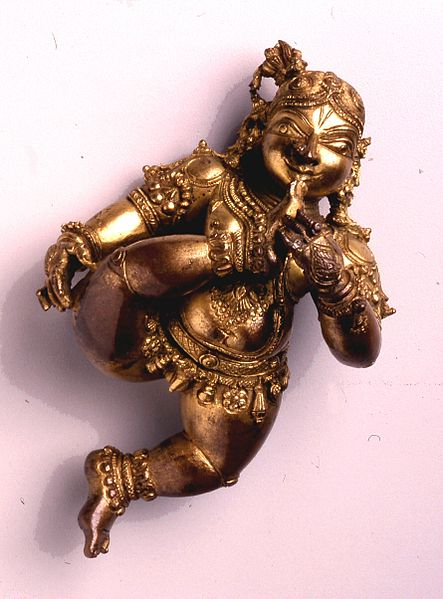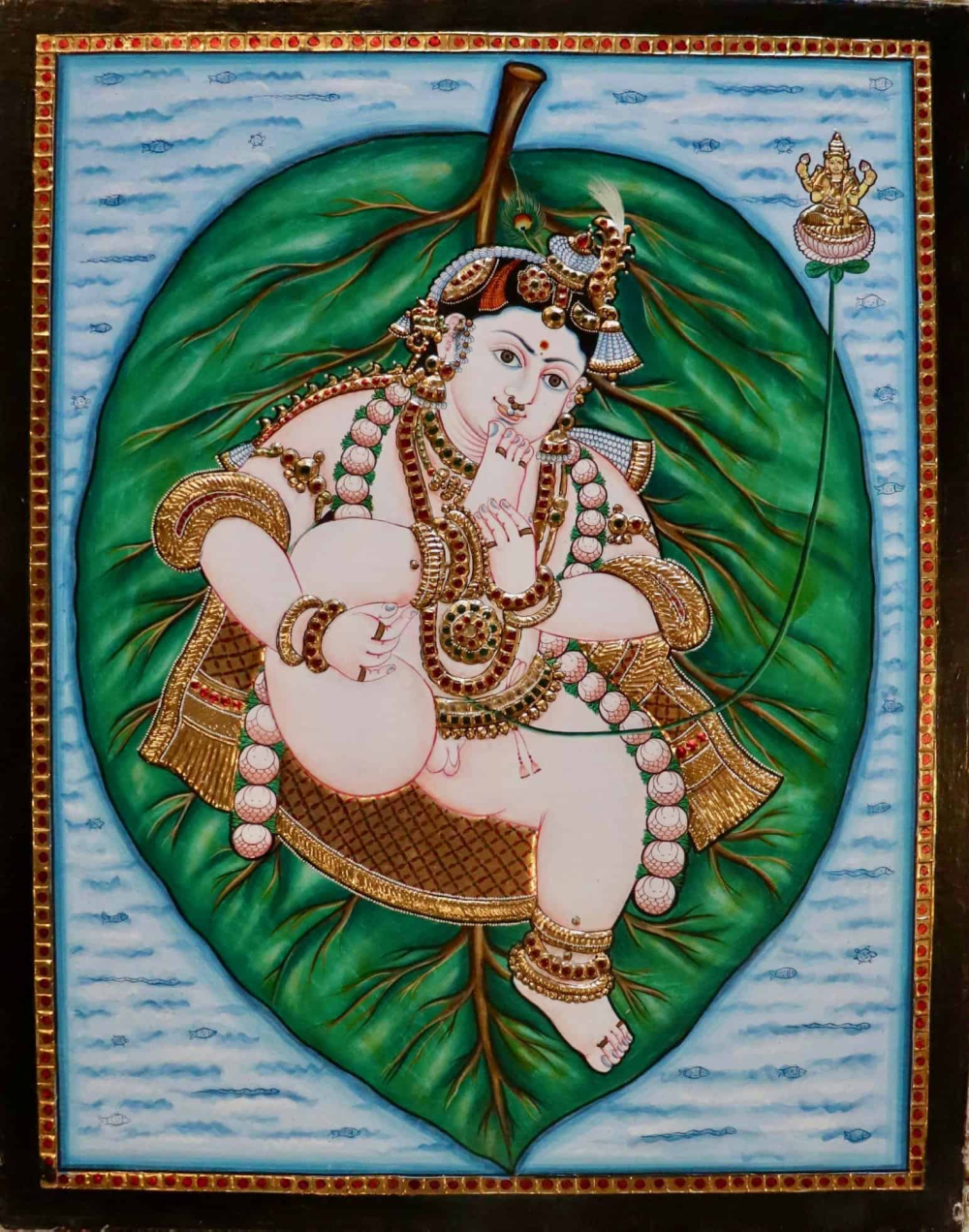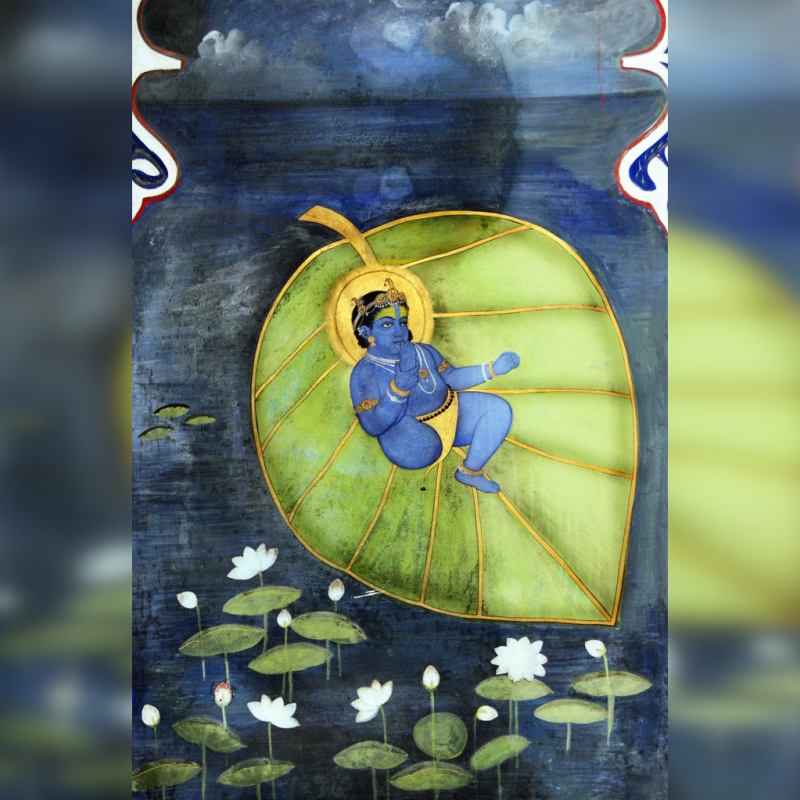Krishna, an avatar of Vishnu, is an important deity who is worshipped by millions of people across India. Here, we delve deeper into one of the more popular images of Krishna—Vatapatrasayi, Lord of the Banyan Leaf—which has been beautifully rendered in both Indian paintings and sculptures. (Photo Courtesy: ૐ Didi ૐ /Flickr)
Why do great sages turn away from nectar and drink the water from my lotus feet? Thought the baby, Gopala bala, and eagerly sucked his lotus foot. May he bless you with good fortune.[i]
Bala Gopala, the miraculous baby Krishna, lies on a banyan leaf, content, innocent, with a hint of amusement on his face. All around him, waters rise to submerge the continents and mountains, drowning every forest, river valley, desert and island. He is unaffected by the pralaya (doomsday), while a sage watches the miracle, amazed.[ii]
In Sanskrit, this particular form of Krishna is called Vatapatrasayi, Lord of the Banyan Leaf. It is one of the more popular images of the god, beautifully rendered in both Indian paintings and sculptures. A plethora of myths and stories from Krishna’s infancy and childhood revolve around this theme of a saviour god. As an infant, he slays the evil demoness Putana, as an adolescent he tames Kaliya, the monstrous serpent, and as Govardhan-dhari, he lifts a mountain to save his people and cattle from the incessant rain. The most compelling tale, however, is of baby Krishna as the ultimate saviour of the universe.
While there are different versions of the pralaya myth in scriptures like the Mahabharata, the Matsya Purana and the Bhagavat Purana, the idea is similar. During the dissolution of the universe, the sage Markandeya witnesses the horror of the great deluge, as humanity disappears under water. Suddenly, he spots a little child floating on a banyan leaf on the dangerous torrents, grabbing his lotus-like toe and placing it in his mouth.[iii] Markandeya finds himself sucked into the baby’s body and, to his surprise, discovers the whole world, with all its realms, safely tucked inside the child, quite oblivious to the calamity outside. The great sage then realises that the baby is a god, who has withdrawn the world into himself before recreating the universe.
Vatapatrasayi in Temple Architecture
Historically, the Alvar community of South India popularised the theme of Vatapatrasayi. These Tamil poet-saints invoked baby Krishna as the god of the banyan leaf in their hymns. In the eighth century, Periyalvar adored Vishnu in a temple named Vatapatrasayi at Srivilliputtur near Madurai. His foster daughter, Andal, composed passionate hymns, often referring to Krishna as ‘the one lying on the banyan leaf’. A theme of great cosmological, philosophical and devotional significance, this motif was first seen in South Indian temples from the ninth century onwards, underlining Alvar influence in temple art. The earliest carving is seen on the base mouldings of the Nageshvara Temple in Kumakonam, Thanjavur. Krishna lies on the leaf, holding his raised left foot with his right hand. Another beautiful depiction of the divine child is found on an ornamental arch of the Brahmapurisvara Temple in Pullamangai. Here, he does not suck his toe, but is accompanied by an adoring sage sitting to his left.

Apart from temple motifs, the theme also appears in twelfth-century Chola metal sculptures. These depict a child sucking his toe and are devoid of the popular leaf attachment. Such figures are worshipped by women hoping to be blessed with a child.
Vata-Krishna in Paintings
The first paintings of Vata-Krishna are found in the fifteenth-century Balagopala-stuti manuscripts in western India. These paintings are conventionalised with the same iconography—baby Krishna is shown lying on top of a banyan tree, unlike his representations on a solitary leaf seen earlier in the Chola sculptures. The Pahadi paintings of Guler and Mankot present a rather mellifluous rendition of the subject, with a dark, dynamic backdrop encompassing the crashing waves from which grows a banyan tree. On one leaf lies the miracle baby with his toe in his mouth, on the other lies Markandeya, his terrified face looking at the baby in awe, praying for answers.
In the Nathadwara paintings, Krishna is in a central position amidst the surrounding waters. The scene is peaceful, the waters calm; there are lotuses growing around his leaf, reflecting the lotus-like essence of the child’s feet and lips, so meticulously defined in the epics. He wears a mukuta (crown) and his body is laden with sleek silver jewellery, highlighting certain features of this region of Rajasthan.
In the cloth-painting traditions of the Tirupati School, the viewer’s attention is instantly grabbed by the baby’s eyes—wide and innocent—as he lies completely bejewelled with his toe in his mouth. His leaf is encircled by an intricately detailed school of fish, swimming amidst the primordial waters. The backdrop is white, with stencilled fish representing the presence of water, and a splash of colour embodying Krishna on his vehicle.

Vatapatrasayi is often compared to the popular motif of Sheshasayi Vishnu—the god reclining on the coils of the sea serpent, Shesha. The Pahari regions of Kangra and Chamba are filled with the Sheshasayi motif on sculptures and monuments, specifically found at water bodies.
Referring to both these forms of Vishnu, T.A. Gopinatha Rao wrote:
lt is interesting to compare this conception of God brooding upon the waters of chaos at the time of universal dissolution with that of Vata-patra-sayin, the infant god floating on a banyan leaf in the chaotic waters of the dissolved cosmos, assuring, as it were, that the dissolution of the cosmos is in fact the infancy of its evolution. [iv]
Vatapatrasayi imagery is widely used in the painting traditions of every major Indian school. This visual portrays themes of renewal and innocence—the universe collapses when purity is lost, Krishna births it anew, fresh and uncontaminated. Literature defines society in the image of Purusha, his body parts constituting the four major castes of India. The baby sucking his toe could be a symbolic representation of how Krishna is unbiased. To a child, prejudice is unknown, as biases are fabricated culturally.
The article was also published by The Statesman.
Notes
[i] Devangana Desai, ‘The Lord on the Leaf,’ in Themes, Histories, Interpretations: Indian Painting: Essays in Honour of B.N. Goswamy, ed. Mahesh Sharma and Padma Kaimal, (Ahmedabad: Mapin Publishing, 2013), 32.
[ii] I have culled a gist of the story from my readings of various versions of the Markandeya Purana.
[iii] Vishnu S. Sukhthankar ed., Aranyakaparvan, vol. 4 of Mahabharata (Pune: Bhandarkar Oriental Research Institute, 1942), 186–87.
[iv] T.A. Gopinath Rao, Elements of Hindu Iconography, Vol. 1 Part 1 (Chennai: Law Printing House, 1914), 264.













